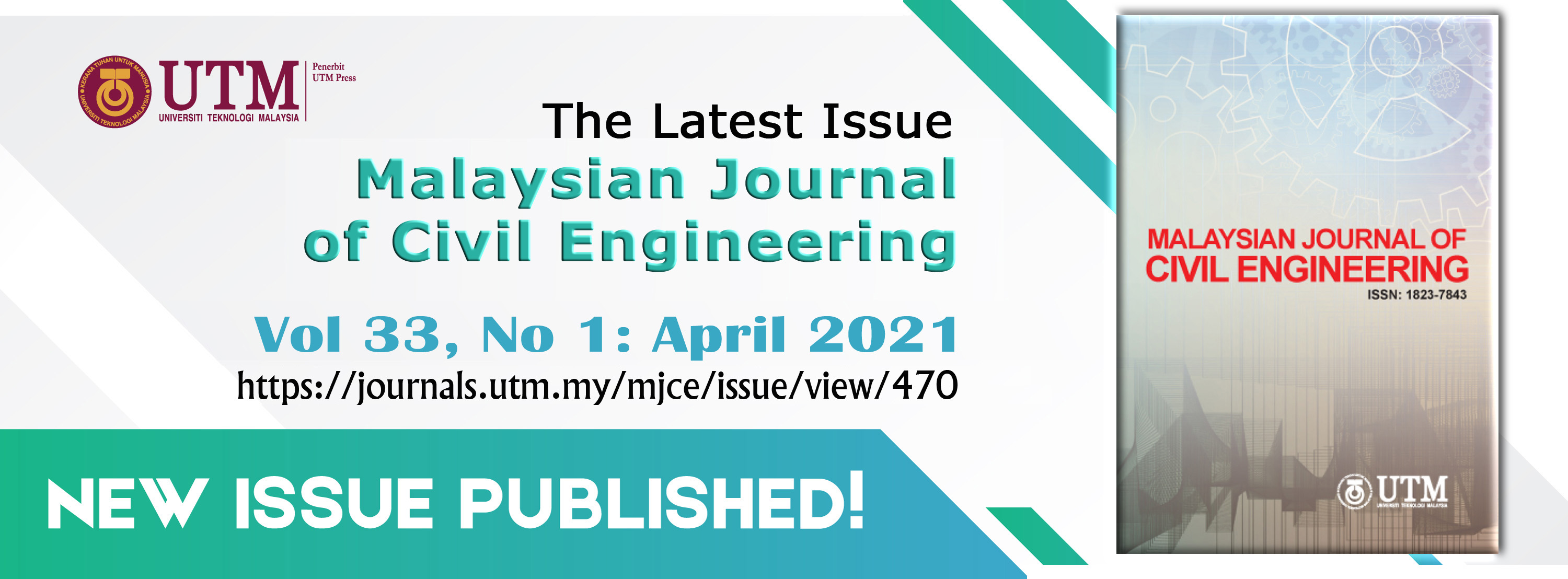EFFECT OF FLY-ASH ON THE STRENGTH DEVELOPMENT OF COASTAL SOILS-A CASE STUDY FOR THE SOUTHERN COASTAL ZONE OF BANGLADESH
DOI:
https://doi.org/10.11113/mjce.v33.16233Keywords:
Fly Ash, Coastal Soils, Chattogram, Ground Improvement, Construction MaterialsAbstract
The rapid demand for urbanization expands the requirements of infrastructures and owing to the scarcity of available firm land; people are now built structures on soft soils. However, the application of a deep foundation for a low-rise structure may not be economically feasible for developing countries. The economic, as well as safe foundation, can be ensured by adopting traditional ground stability approaches. However, replacement of the industrial by-product, which possess minimum environmental threat may be a plausible option for ground stability. Therefore, an attempt is taken in this research to study the improvement of soft coastal soil by replacing with eco-friendly fly ash. The eastern bank of the river Karnaphuli, which has increasing industrial and residential demand is taken as a case study in this research. A series of experimental set-ups have been conducted to evaluate the strength development with different fly ash contents. It is found that the strength of fly ash treated soils increases with fly ash content up to a threshold value, and beyond that, the strength decreases. In addition, compaction and plasticity characteristics are also investigated through experimental observations and show better performance criteria with increasing fly ash contents. In a nutshell, this approach of replacing fly ash is suitable for coastal soil, and the experimental investigation reveals that an optimum 20% of fly ash content is justified.
References
Alam, M. J.; Islam, M. S. Geological Aspects of Soil Formation of Bangladesh. In Proceedings of Bangladesh Geotechnical Conference (BGC-2009), Dhaka, Bangladesh; 2009; pp 174–183.
Khan, M. S. H.; Hossain, M. S.; Uddin, M. A. Geology and Active Tectonics of the Lalmai Hills, Bangladesh–An Overview from Chittagong Tripura Fold Belt Perspective. J. Geol. Soc. India, 2018, 92 (6), 713–720. https://doi.org/10.1007/s12594-018-1093-5.
Samad, R. B.; Chisty, K. U.; Rahman, A. Urbanization and Urban Growth Dynamics : A Study on Chittagong City. J. Bangladesh Inst. Planners, 2015, 8 (December), 167–174.
Yadu, L.; Tripathi, R. K. Effects of Granulated Blast Furnace Slag in the Engineering Behaviour of Stabilized Soft Soil. Procedia Eng., 2013, 51, 125–131. https://doi.org/10.1016/j.proeng.2013.01.019.
Sekhar, D. C.; Nayak, S.; Preetham, H. Influence of Granulated Blast Furnace Slag and Cement on the Strength Properties of Lithomargic Clay. Indian Geotech. J., 2017, 47 (3), 384–392. https://doi.org/10.1007/s40098-017-0228-8.
Sharma, A. K.; Sivapullaiah, P. V. Ground Granulated Blast Furnace Slag Amended Fly Ash as an Expansive Soil Stabilizer. Soils Found., 2016, 56 (2), 205–212. https://doi.org/10.1016/j.sandf.2016.02.004.
Rahgozar, M. A.; Saberian, M.; Li, J. Soil Stabilization with Non-Conventional Eco-Friendly Agricultural Waste Materials: An Experimental Study. Transp. Geotech., 2018, 14, 52–60. https://doi.org/10.1016/j.trgeo.2017.09.004.
Maaitah, O. N. Soil Stabilization by Chemical Agent. Geotech. Geol. Eng., 2012, 30 (6), 1345–1356. https://doi.org/10.1007/s10706-012-9549-7.
Ghazali, N.; Muthusamy, K.; Wan Ahmad, S. Utilization of Fly Ash in Construction. IOP Conf. Ser. Mater. Sci. Eng., 2019, 601, 012023. https://doi.org/10.1088/1757-899x/601/1/012023.
Simatupang, M.; Mangalla, L. K.; Edwin, R. S.; Putra, A. A.; Azikin, M. T.; Aswad, N. H.; Mustika, W. The Mechanical Properties of Fly-Ash-Stabilized Sands. Geosci., 2020, 10 (4). https://doi.org/10.3390/geosciences10040132.
Nalbantoǧlu, Z. Effectiveness of Class C Fly Ash as an Expansive Soil Stabilizer. Constr. Build. Mater., 2004, 18 (6), 377–381. https://doi.org/10.1016/j.conbuildmat.2004.03.011.
Han, F.; Wu, L. Industrial Solid Waste Recycling in Western China; 2019. https://doi.org/10.1007/978-981-13-8086-0.
Zha, F.; Liu, S.; Du, Y.; Cui, K. Behavior of Expansive Soils Stabilized with Fly Ash. Nat. Hazards, 2008, 47 (3), 509–523. https://doi.org/10.1007/s11069-008-9236-4.
Horpibulsuk, S.; Rachan, R.; Raksachon, Y. Role of Fly Ash on Strength and Microstructure Development in Blended Cement Stabilized Silty Clay. Soils Found., 2009, 49 (1), 85–98. https://doi.org/10.3208/sandf.49.85.
Nath, B. D.; Molla, M. K. A.; Sarkar, G. Study on Strength Behavior of Organic Soil Stabilized with Fly Ash. Int. Sch. Res. Not., 2017, 2017, 1–6. https://doi.org/10.1155/2017/5786541.
Sezer, A.; Inan, G.; Yilmaz, H. R.; Ramyar, K. Utilization of a Very High Lime Fly Ash for Improvement of Izmir Clay. Build. Environ., 2006, 41 (2), 150–155. https://doi.org/10.1016/j.buildenv.2004.12.009.
Erdal Cokca. Use of Class C fly Ashes for the Stabilization of an Expansive Soil. J. Geotech. Geoenvironmental Eng., 2001, 127(7) (July), 568–573. https://doi.org/10.1017/CBO9781107415324.004.
Ali, F. H.; Adnan, A.; Choy, C. K. Use of Rice Husk Ash to Enhance Lime Treatment of Soil. Can. Geotech. J., 1992, 29 (5), 843–852. https://doi.org/10.1139/t92-091.
Hossain, K. M. .; Lachemi, M.; Easa, S. Characteristics of Volcanic Ash and Natural Lime Based Stabilized Clayey Soils. Can. J. Civ. Eng., 2006, 33 (11), 1455–1458. https://doi.org/10.1139/l06-099.
Amadi, A. A.; Osu, A. S. Effect of Curing Time on Strength Development in Black Cotton Soil – Quarry Fines Composite Stabilized with Cement Kiln Dust (CKD). J. King Saud Univ. - Eng. Sci., 2018, 30 (4), 305–312. https://doi.org/10.1016/j.jksues.2016.04.001.
Bell, F. G. Lime Stabilization of Clay Minerals and Soils. Eng. Geol., 1996, 42, 223–237. https://doi.org/10.1299/jsme1958.26.1404.
Patel, S.; Shahu, J. T. Engineering Properties of Black Cotton Soil-Dolime Mix for Its Use as Subbase Material in Pavements. Int. J. GEOMATE, 2015, 8 (1), 1159–1166. https://doi.org/10.21660/2015.15.4191.
Lambe, T. W.; Whitman, R. V. Soil Mechanics, SI version.; John Wiley & Sons: New York, 1969.
Shi, W.; Chen, X.; Yang, J.; Han, J.; Khan, M. S. H.; Hossain, M. S.; Uddin, M. A.; Turan Javadi, A., Vinai, R., Cuisinier, O., Russo, G., & Consoli, N. C., C.; Otoko, G. R.; Isima, M. I.; et al. Mechanical Properties of Fly Ash Stabilized Clayey Laterite. J. Geol. Soc. India, 2011, 12 (4), 713–720. https://doi.org/10.1080/14680629.2011.9695266.
Turan Javadi, A., Vinai, R., Cuisinier, O., Russo, G., & Consoli, N. C., C. Mechanical Properties of Calcareous Fly Ash Stabilized Soil. 2019, No. June.
















